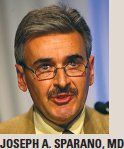Multigene assays influence treatment decisions in low-risk breast cancer patients
Tests carry a significant price tag, but reduction in chemotherapy use is potentially cost-saving.
ABSTRACT: Tests carry a significant price tag, but reduction in chemotherapy use is potentially cost-saving.
Incorporating the 21-gene recurrence score assay (Oncotype DX) into the management of patients with lymph node-negative, estrogen receptor-positive breast cancer resulted in a substantial change in treatment decisions, according to a study out of Loyola University Medical Center in Maywood, Ill. RS assay results also increased confidence in treatment recommendations for 76% of oncologists and decreased patient anxiety and conflict about therapy.
The cost of the RS assay is about $4,000 per patient. Many insurers, including Medicare, provide reimbursement for the test for LN-negative, ER-positive, stage I and II breast cancer. A cost analysis on Genomic Health's website shows that use of the RS test can save hundreds of thousands of dollars by sparing patients from unnecessary chemotherapy. Other commercially available multigene assays include a 70-gene expression profile (Mammaprint) and a 50-gene expression profile (PAM50).

"In this study, 97% of medical oncologists said they would order the RS assay again in a similar group of patients. Among the 46% of oncologists who used Adjuvant Online! to make treatment decisions, 71% thought the RS assay provided additional information. Use of Adjuvant Online! did not affect the rate of treatment recommendation change after RS assay results became available," said lead author Shelly S. Lo, MD, an assistant professor of medicine in hematology/oncology and hospice program director at Loyola University Medical Center and the Cardinal Bernardin Cancer Center.
RS assay results are easily interpreted for low-risk patients and for high-risk patients: low-risk patients (RS score < 18) can be treated with hormonal therapy (HT) alone and do not require chemotherapy, whereas high-risk patients (RS score > 31) should receive both HT and chemotherapy.
The RS assay has been validated to quantify the risk of distant recurrence in tamoxifen-treated patients with LN-negative, ER-positive breast cancer and to predict the magnitude of chemotherapy benefit, Dr. Lo explained. The present study was conducted to determine the impact of RS assay results on physician and patient adjuvant treatment selection and satisfaction.
The study included 89 assessable patients treated by 17 medical oncologists at one community center and three academic practices. Mean age of patients was 55 years, 86.2% were white, and 100% had ECOG performance status of 0 to 1.
Mean tumor size was 1.7 cm (range, 0.6 to 3.5 cm). Sixty-five percent were stage I and 35% were stage II. Twenty-one percent of patients had low-grade tumors, 65.2% had intermediate-grade tumors, and 13.5% had high-grade tumors. Mean RS score was 19.5 (range, 2 to 56).
Medical oncologists were asked to state their adjuvant treatment recommendations and level of confidence in these decisions both before and after the RS assay. Patients also indicated their treatment choices pre- and post-RS assay. In addition, patients were evaluated for decision conflict, anxiety, and quality of life.
Medical oncologists' treatment recommendations changed post-RS assay for 28 patients (31.5%), and 24 patients (27%) changed their treatment decisions after receiving RS assay results. Pre-RS assay, medical oncologists recommended chemotherapy plus HT to 42 patients (47%), HT alone to 46 patients (51.7%), and either chemotherapy or HT to one patient (1.1%). Most of the change after RS results was driven by oncologists' converting from a pretest recommendation for HT and chemotherapy to a post-test recommendation for HT alone (20 cases, 22.5%).
Treatment recommendations post-RS assay were consistent with test results. All nine high-risk RS patients were recommended to have chemotherapy and HT; chemotherapy was recommended to 11 patients (26.2%) in the intermediate-risk RS group, and to three patients (7.9%) in the low-risk RS group. HT alone was recommended to 22 patients (87%) in the low-risk RS group, 27 (64.3%) in the intermediate risk RS group, and to no patient with high-risk RS scores. Nine patients (10.1%) changed their treatment decision from chemotherapy plus HT to HT alone post-RS assay (J Clin Oncol 28:1671-1676, 2010).
"It is unclear whether all patients with LN-negative, ER-positive breast cancer should have the RS assay ordered and what is the optimal treatment for patients whose RS scores are in the intermediate range [RS score 18 to 30]," Dr. Lo said.
However, oncologists and patients agreed on breast cancer adjuvant treatment decisions most of the time, she said. n
VANTAGE POINT Risk assessment tools: Enlightening providers and patients


Physicians may be reassured that these study results show "the judicious use of RS in appropriately selected patients with early stage, ER-positive breast cancer frequently impacts therapeutic decisions in a manner that benefits patients," wrote Dr. Sparano and Dr. Solin in an accompanying editorial.
Dr. Sparano is a medical oncologist at Montefiore Medical Center, Albert Einstein College of Medicine and Cancer Center in New York. Dr. Solin is chair of the radiation oncology department at Albert Einstein Medical Center in Philadelphia.
They noted that although the cost of the 21-gene RS assay and other multigene assays is higher than the cost of tests for standard risk factors, such as estrogen receptor status or HER2/neu status, the reduction in chemotherapy use is potentially cost-saving.
Dr. Sparano and Dr. Solin agreed that multiparameter assays will not replace classic clinical and pathological features in determining treatment, but that these tools should be used together to make the most informed management recommendations possible (J Clin Oncol 28:1625-1626, 2010).
Newsletter
Stay up to date on recent advances in the multidisciplinary approach to cancer.